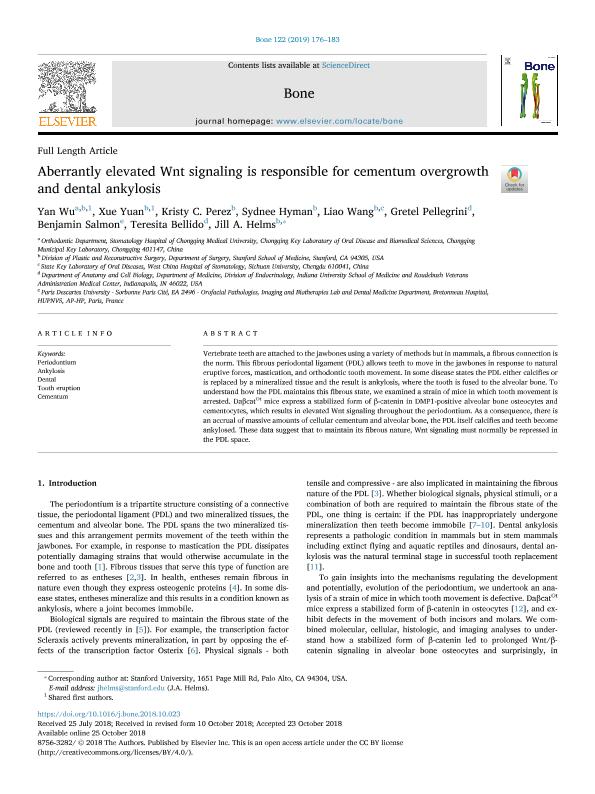Mostrar el registro sencillo del ítem
dc.contributor.author
Wu, Yan
dc.contributor.author
Yuan, Xue
dc.contributor.author
Perez, Kristy C.
dc.contributor.author
Hyman, Sydnee
dc.contributor.author
Wang, Liao
dc.contributor.author
Pellegrini, Gretel Gisela

dc.contributor.author
Salmon, Benjamin
dc.contributor.author
Bellido, Teresita

dc.contributor.author
Helms, Jill A.
dc.date.available
2020-07-31T20:22:17Z
dc.date.issued
2019-05
dc.identifier.citation
Wu, Yan; Yuan, Xue; Perez, Kristy C.; Hyman, Sydnee; Wang, Liao; et al.; Aberrantly elevated Wnt signaling is responsible for cementum overgrowth and dental ankylosis; Elsevier Inc; Bone; 122; 5-2019; 176-183
dc.identifier.issn
8756-3282
dc.identifier.uri
http://hdl.handle.net/11336/110689
dc.description.abstract
Vertebrate teeth are attached to the jawbones using a variety of methods but in mammals, a fibrous connection is the norm. This fibrous periodontal ligament (PDL) allows teeth to move in the jawbones in response to natural eruptive forces, mastication, and orthodontic tooth movement. In some disease states the PDL either calcifies or is replaced by a mineralized tissue and the result is ankylosis, where the tooth is fused to the alveolar bone. To understand how the PDL maintains this fibrous state, we examined a strain of mice in which tooth movement is arrested. DaβcatOt mice express a stabilized form of β-catenin in DMP1-positive alveolar bone osteocytes and cementocytes, which results in elevated Wnt signaling throughout the periodontium. As a consequence, there is an accrual of massive amounts of cellular cementum and alveolar bone, the PDL itself calcifies and teeth become ankylosed. These data suggest that to maintain its fibrous nature, Wnt signaling must normally be repressed in the PDL space.
dc.format
application/pdf
dc.language.iso
eng
dc.publisher
Elsevier Inc

dc.rights
info:eu-repo/semantics/openAccess
dc.rights.uri
https://creativecommons.org/licenses/by/2.5/ar/
dc.subject
ANKYLOSIS
dc.subject
CEMENTUM
dc.subject
DENTAL
dc.subject
PERIODONTIUM
dc.subject
TOOTH ERUPTION
dc.subject.classification
Anatomía y Morfología

dc.subject.classification
Medicina Básica

dc.subject.classification
CIENCIAS MÉDICAS Y DE LA SALUD

dc.title
Aberrantly elevated Wnt signaling is responsible for cementum overgrowth and dental ankylosis
dc.type
info:eu-repo/semantics/article
dc.type
info:ar-repo/semantics/artículo
dc.type
info:eu-repo/semantics/publishedVersion
dc.date.updated
2020-04-24T18:00:07Z
dc.journal.volume
122
dc.journal.pagination
176-183
dc.journal.pais
Estados Unidos

dc.description.fil
Fil: Wu, Yan. Stomatology Hospital of Chongqing Medical University; China. University of Stanford; Estados Unidos
dc.description.fil
Fil: Yuan, Xue. University of Stanford; Estados Unidos
dc.description.fil
Fil: Perez, Kristy C.. University of Stanford; Estados Unidos
dc.description.fil
Fil: Hyman, Sydnee. University of Stanford; Estados Unidos
dc.description.fil
Fil: Wang, Liao. University of Stanford; Estados Unidos. Sichuan University; China
dc.description.fil
Fil: Pellegrini, Gretel Gisela. Indiana University; Estados Unidos. Consejo Nacional de Investigaciones Científicas y Técnicas. Oficina de Coordinación Administrativa Houssay. Instituto de Inmunología, Genética y Metabolismo. Universidad de Buenos Aires. Facultad de Medicina. Instituto de Inmunología, Genética y Metabolismo; Argentina
dc.description.fil
Fil: Salmon, Benjamin. Paris Descartes University; Francia
dc.description.fil
Fil: Bellido, Teresita. Indiana University; Estados Unidos
dc.description.fil
Fil: Helms, Jill A.. University of Stanford; Estados Unidos
dc.journal.title
Bone

dc.relation.alternativeid
info:eu-repo/semantics/altIdentifier/doi/https://doi.org/10.1016/j.bone.2018.10.023
dc.relation.alternativeid
info:eu-repo/semantics/altIdentifier/url/https://www.sciencedirect.com/science/article/pii/S8756328218304034
Archivos asociados
